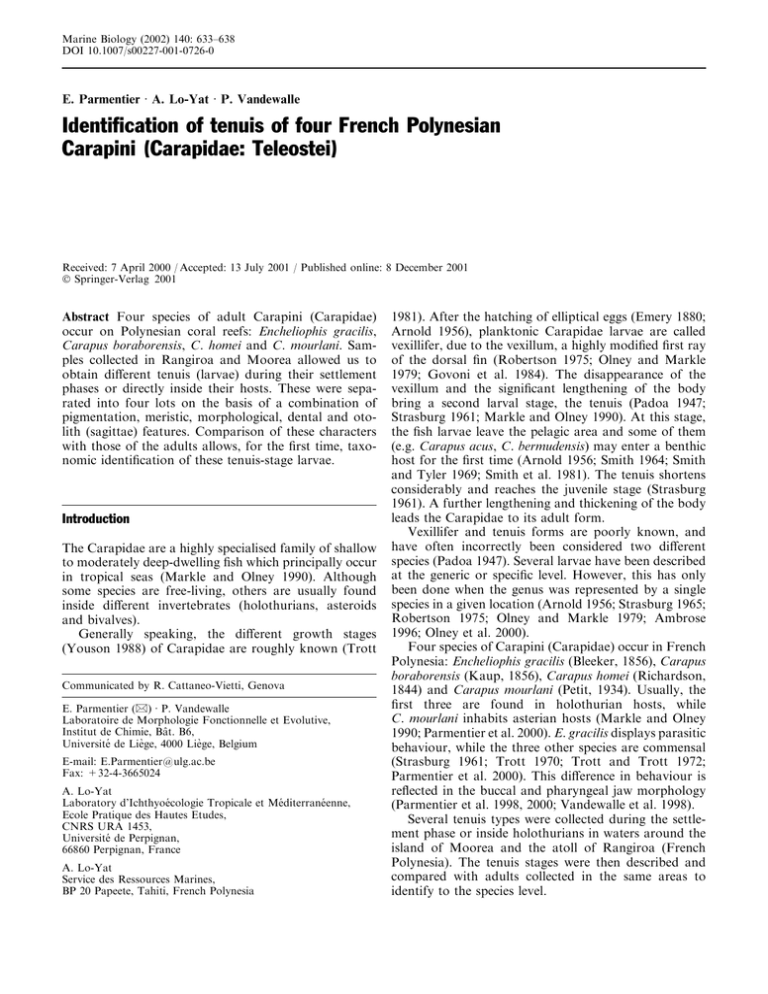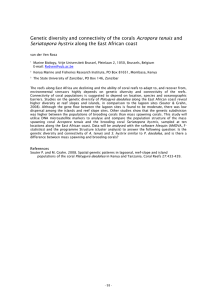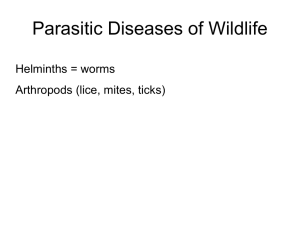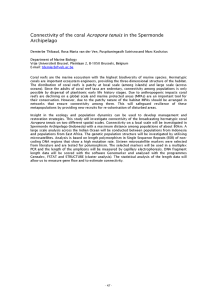Identification of tenuis of four French Polynesian Carapini (Carapidae: Teleostei)
advertisement

Marine Biology (2002) 140: 633–638 DOI 10.1007/s00227-001-0726-0 E. Parmentier Æ A. Lo-Yat Æ P. Vandewalle Identification of tenuis of four French Polynesian Carapini (Carapidae: Teleostei) Received: 7 April 2000 / Accepted: 13 July 2001 / Published online: 8 December 2001 Springer-Verlag 2001 Abstract Four species of adult Carapini (Carapidae) occur on Polynesian coral reefs: Encheliophis gracilis, Carapus boraborensis, C. homei and C. mourlani. Samples collected in Rangiroa and Moorea allowed us to obtain different tenuis (larvae) during their settlement phases or directly inside their hosts. These were separated into four lots on the basis of a combination of pigmentation, meristic, morphological, dental and otolith (sagittae) features. Comparison of these characters with those of the adults allows, for the first time, taxonomic identification of these tenuis-stage larvae. Introduction The Carapidae are a highly specialised family of shallow to moderately deep-dwelling fish which principally occur in tropical seas (Markle and Olney 1990). Although some species are free-living, others are usually found inside different invertebrates (holothurians, asteroids and bivalves). Generally speaking, the different growth stages (Youson 1988) of Carapidae are roughly known (Trott Communicated by R. Cattaneo-Vietti, Genova E. Parmentier (&) Æ P. Vandewalle Laboratoire de Morphologie Fonctionnelle et Evolutive, Institut de Chimie, Bât. B6, Université de Liège, 4000 Liège, Belgium E-mail: E.Parmentier@ulg.ac.be Fax: +32-4-3665024 A. Lo-Yat Laboratory d’Ichthyoécologie Tropicale et Méditerranéenne, Ecole Pratique des Hautes Etudes, CNRS URA 1453, Université de Perpignan, 66860 Perpignan, France A. Lo-Yat Service des Ressources Marines, BP 20 Papeete, Tahiti, French Polynesia 1981). After the hatching of elliptical eggs (Emery 1880; Arnold 1956), planktonic Carapidae larvae are called vexillifer, due to the vexillum, a highly modified first ray of the dorsal fin (Robertson 1975; Olney and Markle 1979; Govoni et al. 1984). The disappearance of the vexillum and the significant lengthening of the body bring a second larval stage, the tenuis (Padoa 1947; Strasburg 1961; Markle and Olney 1990). At this stage, the fish larvae leave the pelagic area and some of them (e.g. Carapus acus, C. bermudensis) may enter a benthic host for the first time (Arnold 1956; Smith 1964; Smith and Tyler 1969; Smith et al. 1981). The tenuis shortens considerably and reaches the juvenile stage (Strasburg 1961). A further lengthening and thickening of the body leads the Carapidae to its adult form. Vexillifer and tenuis forms are poorly known, and have often incorrectly been considered two different species (Padoa 1947). Several larvae have been described at the generic or specific level. However, this has only been done when the genus was represented by a single species in a given location (Arnold 1956; Strasburg 1965; Robertson 1975; Olney and Markle 1979; Ambrose 1996; Olney et al. 2000). Four species of Carapini (Carapidae) occur in French Polynesia: Encheliophis gracilis (Bleeker, 1856), Carapus boraborensis (Kaup, 1856), Carapus homei (Richardson, 1844) and Carapus mourlani (Petit, 1934). Usually, the first three are found in holothurian hosts, while C. mourlani inhabits asterian hosts (Markle and Olney 1990; Parmentier et al. 2000). E. gracilis displays parasitic behaviour, while the three other species are commensal (Strasburg 1961; Trott 1970; Trott and Trott 1972; Parmentier et al. 2000). This difference in behaviour is reflected in the buccal and pharyngeal jaw morphology (Parmentier et al. 1998, 2000; Vandewalle et al. 1998). Several tenuis types were collected during the settlement phase or inside holothurians in waters around the island of Moorea and the atoll of Rangiroa (French Polynesia). The tenuis stages were then described and compared with adults collected in the same areas to identify to the species level. 634 Materials and methods Adult specimens of Carapus mourlani, C. boraborensis, C. homei and Encheliophis gracilis were collected in front of the Opunohu Bay, Moorea, French Polynesia. The first species was found in the coelomic cavity of Culcita novaeguineae (asterid), and the three others were either in the coelomic cavity or in the respiratory trees of three holothurians: Bohadschia argus, Thelenota ananas and T. anax. These echinoderms were collected using SCUBA diving at depths from 3 to 20 m between July and August 2000. C. boraborensis and C. homei tenuis were also found in B. argus and T. ananas. During the same period, C. homei and C. mourlani tenuis were caught at night as they arrived on the reef crest; the net (1.5 m wide·0.75 m high·5 m long, 1 mm mesh net) was similar to one used by Dufour et al. (1996). C. boraborensis, C. homei and E. gracilis tenuis were also caught during January and February 1998 on the North coast of the Rangiroa atoll. All specimens were stored in 70% ethanol. A total of 19 tenuis and 4 adults of C. homei, 11 tenuis and 6 adults of C. boraborensis, 3 tenuis and 3 adults of C. mourlani and 3 tenuis and 3 adults of E. gracilis were used. Optical sections of sagittal otoliths were prepared by mounting otoliths on a glass side in the thermoplastic cement Crystal Bond. A double polishing procedure in a frontal plane was used to obtain thin sections (10–40 lm) of the sagitta. Ventral and dorsal sides were polished with different grained sandpaper (600–800 and 1200 grain sizes). A 0.3 lm grained paper was then used for the fine polishing. The sections were observed with a polarising Olympus BX50 microscope coupled with an Olympus OM-4 Ti camera. Different specimens (adult and tenuis) of each species were stained with alizarin red S according to Taylor and Van Dyke’s method (1985). However, the tenuis were not bleached with H2O2, to avoid breaking the melanophores. The stained fish were dissected and examined with a Wild M10 binocular coupled with a camera lucida. pterygiophores. C. homei and C. mourlani have similar coloration patterns: orange-coloured spots are present on the anal fin, on the dorsal side of the neurocranium and on the abdominal cavity, behind the scapula. However, circular melanophores are present on the dorsal side of the swim bladder only in C. mourlani (Fig. 1). In the three other species, dorsally the swim bladder has star-shaped melanophores giving an overall brownish tint (Fig. 1). Morphometry and meristics Body and head length are shown in Table 1. Total length was not measurable for all the specimens due to the fragile nature of the caudal filament. Head length (from the symphisis of the upper jaws to the posterior end of the opercle) was measured on alizarin-stained specimens. C. boraborensis tenuis are the smallest, E. gracilis have an intermediate length, while C. homei and C. mourlani are the longest. Meristic counts are presented in Table 2. With the available data, only C. homei is distinguishable from the others by the number of anal rays to the 31st vertebra (A30) and the number of anal rays to the dorsal fin origin (ARDO). Results Based on a combination of features related to their pigmentation, skull morphology, dentition and otoliths (sagittae), whole examined tenuis larvae were sorted into four groups. Comparison of tenuis characters with the previously described adult features (Markle and Olney 1990; Parmentier et al. 1998, 2000; Vandewalle et al. 1998; present study) enabled identification to species level. Tenuis species is given in both text and figures to avoid confusion. Patterns of coloration All the species show melanophores, more-or-less burst, arranged in a rosette around each nostril. Encheliophis gracilis is distinguishable from the three other species by the distribution of reddish spots on the translucent body of the living animal. The three other tenuis also have a translucent body with inconspicuous and scattered pigmentation. The staining, according to the slightly modified Taylor and Van Dyke (1985) method, allows better retention of the melanophores but not the erythrophores (red chromatophores). Only the stained Carapus boraborensis tenuis has minute brown melanophores situated on the anal fin, between the Fig. 1 Carapus spp. Lateral view of the anterior part of the vertebral column and of the swim bladder in C. homei (upper panel) and C. mourlani (lower panel) (NE neural spine; MEL melanocyte; SB swim bladder; V vertebra, with position number) Table 1 Carapus spp., Encheliophis gracilis. Head length (HL) and body length (TL) in the four Carapini tenuis C. homei TL 149–183 mm (n=10) HL 4–5.2 mm (n=10) E. gracilis C. boraborensis C. mourlani 115–118 mm (n=3) 3.5–4.3 (n=3) 88–97 mm (n=5) 3–3.7 mm (n=5) 145–149 mm (n=2) 4.1–4.5 mm (n=2) 635 Table 2 Carapus spp., Encheliophis gracilis. Ranges of meristic values in tenuis and adult Carapini. Data for adults are from Markle and Olney (1990) (D30 dorsal fin rays to 31st vertebra; A30 anal fin rays to 31st vertebra; VDO vertebra to dorsal fin origin; VAO vertebra to anal fin origin; ARDO anal fin rays to dorsal fin origin) Tenuis C. homei (n=5) C. boraborensis (n=6) E. gracilis (n=2) C. mourlani (n=2) Adult C. homei (n=37) C. boraborensis (n=41) E. gracilis (n=49) C. mourlani (n=40) Morphology and dentition The adult skull bones are present in the tenuis of the four species, but the calcification is incomplete (Fig. 2). The premaxillaries of E. gracilis, C. boraborensis, C. homei and C. mourlani tenuis bear a single cardiform tooth anteriorly, under the premaxillary ascendant process. The other teeth of the upper jaw are different in number and in size among the four species. C. boraborensis tenuis possess minute teeth along the entire length of the premaxillary (Fig. 2). C. homei and C. mourlani tenuis have larger conical teeth, but these are not present on the posterior part of the premaxillary. A few smaller teeth are also present on the anterior part of the premaxillary in E. gracilis (Fig. 2). The dentary of E. gracilis, C. mourlani and C. homei tenuis is characterised by conical teeth in a single row, while that of the C. boraborensis tenuis has minute teeth similar to those on its premaxillary. Small conical palatine teeth were found in the tenuis of all species except C. boraborensis. All bones constituting the adult branchial arcs are present in the tenuis, although calcification and dentition are incomplete. E. gracilis tenuis are characterised by cardiform teeth located on the inner lateral side of the 5th ceratobranchials (Fig. 3). These teeth are conical and situated on the 5th ceratobranchials’ upper face in the three other species. E. gracilis tenuis is also the only one to possess long and tapered teeth on the upper pharyngeal jaws (2nd, 3rd and 4th pharyngobranchials). These are shorter and thicker in C. boraborensis, C. homei and C. mourlani. The four species’ tenuis have three gill rakers on the posterior part of the first ceratobranchial. These correspond to the developed gill rakers observed in the adults (Vandewalle et al. 1998). However, the small conical gill raker teeth are not yet present in all tenuis. As in the adult, gill raker teeth of the C. homei tenuis are set dorsally in a single row. However, one to three teeth can be set in a second row at the basis of the C. homei adult gill raker (Fig. 4). Gill raker teeth are arranged dorsally in two rows in both the tenuis and the adult of C. mourlani. More than two rows are present in both the tenuis and the adult of C. boraborensis. However, the small number of teeth borne on the tenuis gill rakers of C. mourlani and C. boraborensis does not always distinguish the two species. The gill rakers of the E. gracilis D30 A30 VDO VAO ARDO 37–40 34–38 34 33–34 57–62 46–50 44–45 51–57 12–13 12–13 13–14 11–14 6–7 6–7 7 6–7 21–23 15–18 17 19–24 33–38 31–42 25–36 35–41 53–61 43–57 42–52 54–61 12–14 11–15 13–17 11–14 1–4 2–5 3–6 2–4 19–26 13–23 19–27 18–25 tenuis can bear up to two teeth, while these gill rakers are atrophied and toothless in the adult (Fig. 4). The tenuis of all four species have pleural ribs on the first three vertebrae (Fig. 2), the third pair has a posterolateral expansion, as is also the case in adults (Courtenay and McKittrick 1970; Markle and Olney 1990). The E. gracilis tenuis has a distinctive feature in the great length of the dorsal side of the first three vertebrae of the neural spine (Fig. 2). Otoliths As in several tropical reef fishes (Wilson and McCormick 1999), the settlement stage of the four Carapidae species coincides with a modification in otolith microstructure, while the increments (i.e. larval ring) before this discontinuity are known to be representative of the duration of pelagic life (Brothers et al. 1983; Wilson and McCormick 1999). It is therefore possible to use otoliths to differentiate between adult and tenuis stages. The more highly marked refringency and the compactness of the larval rings distinguishes them easily from further increments (Fig. 5). In the tenuis, the increment rings occupy most or all of the otolith. Counts of sagitta rings in adult and tenuis stages of the four Carapini species are presented in Table 3. The C. boraborensis sagitta has the lowest number of larval rings, which clearly distinguished it from the other species. Although there is a small difference in the average number of rings between the tenuis and the adult of E. gracilis, there is no overlap with C. boraborensis and C. homei. The ring numbers overlap in C. homei and C. mourlani and do not enable separation of these species. Discussion Carapidae are divided into two subfamilies: Pyramodontinae and Carapinae. According to Markle and Olney (1990), the tenuis stage is a synapomorphy of two Carapinae tribes: Echiodontini and Carapini. However it can be reduced or missing in different species of the Echiodontini tribe (Olney et al. 2000). Adult Carapini possess different autapomorphies (Markle and Olney 1990; Parmentier et al. 2000) among which at least two are 636 Fig. 3a–d Carapus spp., Encheliophis gracilis. Dorsal view of the lower pharyngeal jaw in C. boraborensis (a) and E. gracilis (c). Inner lateral view of the left 5th ceratobranchial in C. boraborensis (b) and E. gracilis (d) Fig. 4 Carapus spp., Encheliophis gracilis. Lateral view of the 2nd gill raker of the first ceratobranchial in adults (left) and tenuis (right) of the four Carapini species Fig. 2a–d Carapus spp., Encheliophis gracilis. Lateral view of the tenuis skull of C. homei (a), C. boraborensis (b), C. mourlani (c) and E. gracilis (d) (AA articuloangular; BOC basioccipital; CT cardiform teeth; DE dentary; EPI epiotic; EXO exoccipital; FR frontal; HM hyomandibular; INT intercalarium; IO interoperculum; LETH lateral ethmoid; MESO mesopterygoid; META metapterygoid; METH mesethmoid; MX maxillary; O operculum; PAR parietal; PAL palatine; PMX premaxillary; PO preoperculum; PSPH parasphenoid; PTOT pterotic; Q quadrate; SO suboperculum; SOC supraoccipital; SPOT sphenotic; SYMP symplectic; VO vomer; V vertebra, with position number) already present in the four studied tenuis lots: the presence of a cardiform tooth on the outer premaxillary side and the posterior expansion of the third pleural rib (Fig. 2). A rosette of melanophores on the snout is a synapomorphy of various vexillifer and tenuis larvae of the Carapini tribe (Arnold 1956; Olney and Markle 1979; Smith et al. 1981; Markle and Olney 1990; Olney et al. 2000). The occurrence of such a rosette on the four studied species confirms their assignment to the Carapini tribe. The tenuis of the four Polynesian Carapidae species may be distinguished by the following characters: 1. Encheliophis gracilis. The tenuis are easily distinguishable from those of the three other species by the presence of reddish spots scattered over the body. Two other features aid the identification: the presence of cardiform teeth on the inner lateral side of the inner pharyngeal jaws (Vandewalle et al. 1998; Parmentier et al. 2000) and the flattened form of the dorsal neural spine (Markle and Olney 1990); both are features encountered in the adult. 2. Carapus boraborensis. The tenuis can be identified by the minute teeth of the jaws, anal fin rays to the 31st vertebra, the small body length (<100 mm) and the presence of small melanophores between the ventral 637 Fig. 5 Carapus boraborensis. Part of the frontal section of an adult C. boraborensis sagitta showing the larval zone (between dotted lines) (arrow increment within the larval zone) Table 3 Carapus spp., Encheliophis gracilis. Otolith increment number in adults and tenuis of the four Carapini species Adult Tenuis C. homei E. gracilis C. boraborensis C. mourlani 81.2±6.3 (n=4) 83±4.4 (n=19) 60.5±0.7 (n=2) 73±1.5 (n=3) 48.8±5.3 (n=6) 48.7±7.2 (n=11) 75.6±12 (n=3) 82.3±5.8 (n=3) fin rays. The small number of larval rings on the sagittae and the teeth on the gill rakers are both features that confirm their assignment to this species. 3. C. homei and C. mourlani. In appearance, the tenuis of both species have very similar colour patterns. Moreover, meristics, morphometrics and the number of larval rings do distinguish them. This situation is found also in the adults of both species (Markle and Olney 1990). According to Shen and Yeh (1987), Machida (1989) and Markle and Olney (1990), the latter are however recognisable on the basis of three features: C. homei possess (a) a translucent body, (b) a swim bladder without a central constriction and (c) are usually commensal in holothurians; while C. mourlani has (a) several melanophores along the body, (b) a swim bladder with a central constriction and (c) preferably inhabits asterians. Moreover, the adult of C. homei has, at the level of the lateral line, an abdominal cavity with glints of silver, while this appears copper coloured in C. mourlani (authors, personal observations). These features are useless in the identification of tenuis larvae because the colour patterns are similar, the swim bladder is not completely formed and the host has not yet been encountered. However, this study has revealed a difference between the tenuis gill raker teeth (when these are present) that is also present in the adult: a single row in C. homei and two rows in C. mourlani. The C. mourlani tenuis also possess circular melanophores on the dorsal part of the swim bladder, while the C. homei tenuis possess star-shaped melanophores. In teleosts of the tropical seas, the number of larval rings is an indicator of the length of time spent in the pelagic stage before the larva settles (e.g. Brothers et al. 1983; Wilson and McCormick 1999). Otolith increments are general considered to be daily (e.g. Victor 1982). C. boraborensis, with the smallest of number rings and, thus, having the shortest pelagic stage, is also the species with the weakest dentition in buccal and pharyngeal jaws and the shortest head and body length. The C. homei tenuis has the longest head and body length with the most well-developed dentition and a high number of larval rings. Its pelagic life, therefore, appears to be longer than that of the C. boraborensis tenuis. However, the adults of the latter attain a larger size (Markle and Olney 1990) and possess better developed dentition than C. homei adults (Parmentier et al. 1999). During the settlement phase, the morphology and dentition of the C. boraborensis tenuis are less developed than those of C. homei. After settlement, the C. boraborensis tenuis does not seem to reach the length of C. homei. The settlement phase, which corresponds to the first contact with a host, and the following metamorphosis (for example the shortening of body length) are not related to growth. In this context, the hypothesis that the host could have an inductor function for metamorphosis is credible and worth further examination. Acknowledgements The authors would like to thank M. Gosselin and M. Kerneur for helping to collect fish from holothurians using SCUBA, V. Dufour and its Aquafish Technology team and the staff of ‘‘l’Antenne du Service des Ressources Marines de Rangiroa’’ in collecting settlement stage larvae, Y. Chancerelle and J. Algret (CRIOBE-EPHE), R. Lecomte-Finiger and E. Poty (ULg) for their participation in making the otolith counts. This work was supported by grant no. 2.4560.96 from ‘‘Fonds National de la Recherche Scientifique de Belgique’’, the ‘‘Laboratoire d’Ichthyoécologie Tropicale et Méditerranéenne’’ and ‘‘Service des Ressources Marines de Rangiroa’’. References Ambrose DA (1996) Carapidae: pearlfishes. In: Moser HG (ed) The early stages of fishes in the California current region, atlas no. 33. Allen Press, Lawrence, Kan., pp 532–533 Arnold DC (1956) A systematic revision of the fishes of the teleost family Carapidae (Percomorphi, Blennioidea), with description of two new species. Bull Br Mus (Nat Hist) Zool 4:247–307 Brothers EB, Williams DMcB, Sale PF (1983) Length of larval life in twelve families of fishes at ‘‘One Tree Lagoon’’, Great Barrier Reef, Australia. Mar Biol 76:319–324 Courtenay WR, McKittrick FA (1970) Sound-producing mechanisms in carapid fishes, with notes on phylogenetic implications. Mar Biol 7:131–137 Dufour V, Riclet E, Lo-Yat A (1996) Colonization of reef fishes at Moorea Island, French Polynesia: temporal and spatial variation of the larval flux. Mar Freshw Res 47:413–422 Emery DC (1880) Contribuzioni all’ Ittiologia. III. Aggiunte alla Sinonimia e alla Storia naturale dei Fierasfer. Mitt Zool Sta Neapol 3:281–283 Govoni JJ, Olney JE, Markle DF, Curtsinger WR (1984) Observations on structure and evaluation of possible functions of the vexillum in larval Carapidae (Ophidiiformes). Bull Mar Sci 34:60–70 Machida Y (1989) New distribution of the pearlfish, C. mourlani, with notes on its morphometry. Jpn J Ichthyol 36:363–368 638 Markle DF, Olney JE (1990) Systematics of the pearlfish (Pisces: Carapidae). Bull Mar Sci 47:269–410 Olney JE, Markle DF (1979) Description and occurrence of vexillifer larvae of Echiodon (Pisces: Carapidae) in the western North Atlantic and notes on other carapid vexillifers. Bull Mar Sci 29:365–379 Olney JE, Leis JM, Rennis DS (2000) Carapidae. In: Leis JM, Carson-Ewart BM (eds) The larvae of Indo-Pacific coastal fishes. Brill, Leiden, pp 104–107 Padoa E (1947) Note di ittologia mediterranea. Nota V. Forme post-larvali e giovanili di Carapus (sin. Fierasfer). Pubbl Stn Zool Napoli 20:111–121 Parmentier E, Chardon M, Poulicek M, Bussers JC, Vandewalle P (1998) Morphology of the buccal apparatus and related structures in four species of Carapidae. Aust J Zool 46:391– 404 Parmentier E, Chardon M, Poulicek M, Bussers JC, Vandewalle P (1999) Morphological particularities of the head in four Carapidae (Ophidiiformes). In: Séret B, Sire JY (eds) Proceedings of the 5th Indo-Pacific Conference. Société Française d’Ichthyologie, Paris, pp 135–146 Parmentier E, Castillo G, Chardon M, Vandewalle P (2000) Phylogenetic analysis of the pearlfish tribe Carapini (Pisces: Carapidae). Acta Zool 81:293–306 Robertson DA (1975) Planktonic stages of the teleost family Carapidae in eastern New Zealand waters. NZ J Mar Freshw Res 9:403–409 Shen SC, Yeh HS (1987) Study on pearlfishes (Ophidiiformes: Carapidae) of Taı̈wan. J Taı̈wan Mus 40:45–56 Smith CL (1964) Some pearlfishes from Guam, with notes on their ecology. Pac Sci 18:34–40 Smith CL, Tyler JC (1969) Observations on the commensal relationship of the western Atlantic pearlfish, Carapus bermudensis, and holothurians. Copeia 1969:206–208 Smith CL, Tyler JC, Feinberg MN (1981) Population ecology and biology of the pearlfish (Carapus bermudensis) in the lagoon at Bimini, Bahamas. Bull Mar Sci 3:876–902 Strasburg DW (1961) Larval carapid fishes from Hawaii, with remarks on the ecology of adults. Copeia 1961:478–480 Strasburg DW (1965) Description of the larvae and familial relationships of the fish Snyderidia canina. Copeia 1965:20–24 Taylor WR, Van Dyke GC (1985) Revised procedure for staining and clearing small fishes and other vertebrates for bone and cartilage study. Cybium 2:107–119 Trott LB (1970) Contribution of the biology of carapid fishes (Paracanthopterygian: Gadiformes). Univ Calif Publ Zool 89:1–41 Trott LB (1981) A general review of the pearlfishes (Pisces, Carapidae). Bull Mar Sci 31:623–629 Trott LB, Trott EB (1972) Pearlfishes (Carapidae: Gadiforme) collected from Puerto Galera, Minobra, Philippines. Copeia 1972:839–843 Tyler JC, Robins CR, Smith CL, Gilmore RG (1992) Deepwater populations of the western Atlantic pearlfish Carapus bermudensis (Ophidiiformes, Carapidae). Bull Mar Sci 51:218–233 Vandewalle P, Parmentier E, Poulicek M, Bussers JC, Chardon M (1998) Distinctive anatomical features of the branchial basket in four Carapidae species (Ophidiiformi, Paracanthopterygii). Eur J Morph 86:153–164 Victor BC (1982) Daily otolith increments and recruitment in two coral-reef wrasses, Thalassoma bifasciatum and Halichores bivitatus. Mar Biol 71:203–208 Wilson DT, McCormick MI (1999) Microstructure of settlementmarks in the otoliths of tropical reef fishes. Mar Biol 134: 29–41 Youson JH (1988) First metamorphosis. In: Hoar WS, Randall DJ (eds) Fish physiology, vol XIB. Academic, London, pp 135–196





